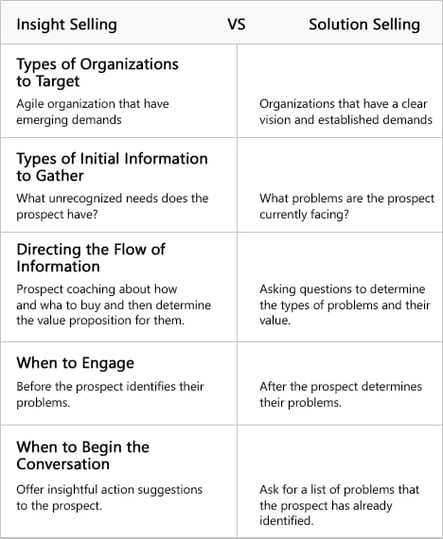If you have been selling into the Business-To-Business world for more than ten years, you recognize that customers do not need you the same way they used to. Something has changed.

Account representatives that embraced solution selling techniques became very successful at discovering their customers’ needs and then selling solutions typically comprised of a combination of products and services. Although customers had a good understanding of their problems, they didn’t necessarily know how to solve them. Now, however, people can easily research and provide themselves their own solutions. This is all made much easier because of the amazing and sometimes dizzying amounts of information made available online. Our customers can access of avenues of information now that only fifteen years ago did not exist, including social media, blogs, subject matter experts, societies, and consultancies, making research much easier to perform.
The Change in the Customers’ Expect
ations of the Sales Representative
As the head of sales for an international software company, I had the opportunity to perform an informal study of over one-hundred organizations of both new customers and decision-makers who did not select us over the past year. I asked three questions concerning their decision and research efforts.
- How much research did they perform prior to contacting our marketing department or sales team?
- Did they find good information or were they confused by the contents they found?
- What types of media did they utilize; industry experts, competitors, blogs, social media, others?
The answers were astounding. It seems that on average nearly seventy-five percent (75%) of them were told by their executive teams to perform extensive research before contacting solution providers and to do the following types of research;—investigate various solutions, ranking the solutions, setting requirements, evaluating pricing, and so on. All this was done before having a conversation with a solution provider. In light of this type of pre-selection research by the majority of prospects, the traditional solution selling sales executive has become irrelevant instead of an asset. Regardless of the industry, such as IT, manufacturing, to service-related industries, the customers are often way ahead of the sales executives who are attempting to “help” them find solutions to their problems.
How Successful Sales Professionals Adapt to Insight Selling
Here is the good news, although traditional representatives are at a distinct disadvantage in this environment, a select group of high performers are flourishing. These superior sales professionals have embraced the new normal and have abandoned much of the conventional wisdom taught in sales organizations. They have adopted the following strategies:
- They target agile organizations in various states of change, rather than ones with a clear understanding of their needs.
- They engage a different group of the customer stakeholders which gives a different perspective of what the company is looking for.
- They coach these change agents on how to evaluate solutions, what to buy, and how to implement, instead of quizzing them about their organizational purchasing process
These sales professionals sell completely differently as well as sell much more effectively. They dramatically increase their performance by changing how they approach their sales fundamentals. To accomplish this paradigm shift in sales techniques, sales management needs to rethink how they train and manage their account executives as well.
Explaining the Solution Selling to Insight Selling Gap
The conventional solution-selling wisdom was that the sales teams were trained to align the customer’s needs to their existing solutions, and then demonstrate why it was better than the competition’s solution. This very practical approach worked and this is where I made my living for more than a decade. When an organization was identified with a recognizable problem that we could solve, we focused on the business owners of the problem areas and gained their “buy-in” and quantified their level of pain monetarily. We then would demonstrate our solution to positive effect to show the problem being alleviated. This was most effective if the executive community was present to see the solution as well.
Some prospects have dramatically departed from this old way of buying and sales management is finding that their teams are increasingly finding their people are being forced into price-reducing bake-offs instead of feature/function/benefit discussions. One representative of an organization told me that his folks were armed to the teeth with a deep understanding of their problem and a well-scoped RFP (request for proposal) for a solution long before they had identified any viable solution providers. He went on to further explain that their goal was not a solution focus, but a pricing battle. This completely negates the value proposition that a sales executive typically brings to the table and relegates the sale to a commodity transaction instead. It was suggested to me that our account representatives must learn to engage prospects much earlier in the sales cycle and preferably before the requirements were determined, and well before customers fully understand their own needs. In this way, the sales team can help determine the value proposition as well as the pain thresholds. This strategy is as old as sales itself: To win a deal, you’ve got to get ahead of the RFP, because an RFP was written by someone for someone and if you are not part of the problem description, there is a high probability that you will not be part of the problem solution. According to my research however, as important as this is, it’s no longer sufficient.
To clarify the sales campaign shift, here is what my best performing sales professionals do differently from my other account representatives concerning how they prioritize their key opportunities, target and engage prospect stakeholder, and execute the sales process. The key finding is this: The top-performing account executives have adopted a radically novel sales approach built on the three strategies identified earlier in this article. Let’s take a close look at each.

